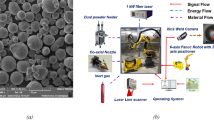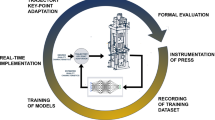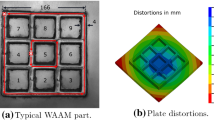Abstract
This study predicts in real time the evolution of temperature and density for arbitrary long tracks in laser-based additive manufacturing using artificial neural networks (ANNs). First, a random laser path is transformed appropriately to serve as an ANN input via a custom trajectory decomposition method providing a local description of each trajectory point relative to its surroundings, which is calculated and load-optimized using K-d trees. For each trajectory point, a “Master” ANN calculates the present temperature, using the trajectory descriptors and previous step temperature as inputs. This is made into a parallel procedure by exploiting a “Pilot” ANN without temperature feedback, making a first pass over the whole trajectory to estimate temperature responses. The Master ANN uses these results as a feedback that is iteratively refined. A “Rider” ANN uses the final temperatures as input and calculates local density evolution. Four hundred fifty finite element model experiments of short random walk trajectories were used for ANN training. Results are presented for various types of laser paths, including random, hatch, spiral, fractal, and spline. ANN simulation execution time consistently taking under 50% of the real process time in all validated cases for track length in excess of 100 m proved the ability of the platform to operate at the full layer-scale of LBAM.















Similar content being viewed by others
References
Aboutaleb AM, Bian L, Elwany A, Shamsaei N, Thompson SM, Tapia G (2017) Accelerated process optimization for laser-based additive manufacturing by leveraging similar prior studies. IISE Trans 49:31–44. https://doi.org/10.1080/0740817X.2016.1189629
Francois MM, Sun A, King WE, Henson NJ, Tourret D, Bronkhorst CA, Carlson NN, Newman CK, Haut T, Bakosi J, Gibbs JW, Livescu V, Vander Wiel SA, Clarke AJ, Schraad MW, Blacker T, Lim H, Rodgers T, Owen S, Abdeljawad F, Madison J, Anderson AT, Fattebert J-L, Ferencz RM, Hodge NE, Khairallah SA, Walton O (2017) Modeling of additive manufacturing processes for metals: challenges and opportunities. Curr Opin Solid State Mater Sci 21:198–206. https://doi.org/10.1016/j.cossms.2016.12.001
Ponche R, Kerbrat O, Mognol P, Hascoet J (2014) A novel methodology of design for additive manufacturing applied to additive laser manufacturing process. Robot Comput Integr Manuf 30:389–398. https://doi.org/10.1016/j.rcim.2013.12.001
King W, Anderson AT, Ferencz RM, Hodge NE, Kamath C, S a K (2015) Overview of modelling and simulation of metal powder bed fusion process at Lawrence Livermore National Laboratory. Mater Sci Technol 31:957–968. https://doi.org/10.1179/1743284714Y.0000000728
Mani M, Lane BM, Donmez MA, Feng SC, Moylan SP (2017) A review on measurement science needs for real-time control of additive manufacturing metal powder bed fusion processes. Int J Prod Res 55:1400–1418. https://doi.org/10.1080/00207543.2016.1223378
Martukanitz R, Michaleris P, Palmer T, DebRoy T, Liu Z-K, Otis R, Heo TW, Chen L-Q (2014) Toward an integrated computational system for describing the additive manufacturing process for metallic materials. Addit Manuf 1(4):52–63. https://doi.org/10.1016/j.addma.2014.09.002
Jared BH, Aguilo MA, Beghini LL, Boyce BL, Clark BW, Cook A, Kaehr BJ, Robbins J (2017) Additive manufacturing: toward holistic design. Scr Mater 135:141–147. https://doi.org/10.1016/j.scriptamat.2017.02.029
Stucker B (2013) Recent trends in additive manufacturing & the need for predictive simulation. Manuf Lett 1:38–41
Williams JD, Deckard CR (1998) Advances in modeling the effects of selected parameters on the SLS process. Rapid Prototyp J 4:90–100
Lavery NP, Brown SGR, Sienz J, Cherry J (2014) A review of computational modelling of additive layer manufacturing – multi-scale and multi-physics. Sustain Des Manuf 1:651–673. https://doi.org/10.13140/RG.2.1.3103.0884
Megahed M, Mindt H-W, N’Dri N, Duan H, Desmaison O (2016) Metal additive-manufacturing process and residual stress modeling. Integrating Materials and Manufacturing Innovation
Zeng K, Pal D, Patil N, Stucker BE (2013) A new dynamic mesh method applied to the simulation of selective laser melting. Proc Solid Free Fabr Symp:549–559
Pal D, Patil N, Zeng K, Stucker B (2014) An integrated approach to additive manufacturing simulations using physics based, coupled multiscale process modeling. J Manuf Sci Eng 136:061022. https://doi.org/10.1115/1.4028580
Keller N, Ploshikhin V (2014) New method for fast predictions of residual stress and distortion of AM parts. Solid Free Fabr Symp Austin, Texas 25
Stathatos E, Vosniakos GC (2017) A computationally efficient universal platform for thermal numerical modeling of laser-based additive manufacturing. Proc Inst Mech Eng C J Mech Eng Sci 232:2317–2333. https://doi.org/10.1177/0954406217720230
Boillat E, Kolossov S, Glardon R, Loher M, Saladin D, Levy G (2004) Finite element and neural network models for process optimization in selective laser sintering. Proc Inst Mech Eng B J Eng Manuf 218:607–614. https://doi.org/10.1243/0954405041167121
Shen X, Yao J, Wang Y, Yang J (2004) Density prediction of selective laser sintering parts based on artificial neural network. In: Yin F-L, Wang J, Guo C (eds) Advances in neural networks - ISNN 2004. Springer Berlin Heidelberg, Berlin, pp 832–840
Fathi A, Mozaffari A (2014) Vector optimization of laser solid freeform fabrication system using a hierarchical mutable smart bee-fuzzy inference system and hybrid NSGA-II/self-organizing map. J Intell Manuf 25:775–795. https://doi.org/10.1007/s10845-012-0718-6
Negi S, Sharma RK (2016) Study on shrinkage behaviour of laser sintered PA 3200GF specimens using RSM and ANN. Rapid Prototyp J 22:645–659. https://doi.org/10.1108/RPJ-08-2014-0090
Mohamed O, Masood S, Bhowmik J (2016) Analytical modelling and optimization of the temperature-dependent dynamic mechanical properties of fused deposition fabricated parts made of PC-ABS. Materials (Basel) 9. https://doi.org/10.3390/ma9110895
Vahabli E, Rahmati S (2016) Application of an RBF neural network for FDM parts’ surface roughness prediction for enhancing surface quality. Int J Precis Eng Manuf 17:1589–1603. https://doi.org/10.1007/s12541-016-0185-7
Kamath C (2016) Data mining and statistical inference in selective laser melting. Int J Adv Manuf Technol 86:1659–1677. https://doi.org/10.1007/s00170-015-8289-2
Garg A, Lam JSL, Savalani MM (2018) Laser power based surface characteristics models for 3-D printing process. J Intell Manuf 29:1191–1202. https://doi.org/10.1007/s10845-015-1167-9
Beale MH, Hagan MT, Demuth HB (2016) Neural network toolbox (TM) user’s guide. MathWorks 1–558. https://doi.org/10.1002/0471221546
Yang J, Bin H, Zhang X, Liu Z (2003) Fractal scanning path generation and control system for selective laser sintering (SLS). Int J Mach Tools Manuf 43:293–300. https://doi.org/10.1016/S0890-6955(02)00212-2
Ma L, Bin H (2007) Temperature and stress analysis and simulation in fractal scanning-based laser sintering. Int J Adv Manuf Technol 34:898–903. https://doi.org/10.1007/s00170-006-0665-5
Yu J, Lin X, Ma L, Wang J, Fu X, Chen J, Huang W (2011) Influence of laser deposition patterns on part distortion, interior quality and mechanical properties by laser solid forming (LSF). Mater Sci Eng A 528:1094–1104. https://doi.org/10.1016/j.msea.2010.09.078
** GQ, Li WD, Tsai CF, Wang L (2011) Adaptive tool-path generation of rapid prototy** for complex product models. J Manuf Syst 30:154–164. https://doi.org/10.1016/j.jmsy.2011.05.007
** GQ, Li WD, Gao L, Popplewell K (2013) A hybrid and adaptive tool-path generation approach of rapid prototy** and manufacturing for biomedical models. Comput Ind 64:336–349. https://doi.org/10.1016/j.compind.2012.12.003
McCulloch WS, Pitts W (1943) A logical calculus of the ideas immanent in nervous activity. Bull Math Biophys 5:115–133. https://doi.org/10.1007/BF02478259
Teti R, Kumara SRT (1997) Intelligent computing methods for manufacturing systems. CIRP Ann Manuf Technol 46:629–652. https://doi.org/10.1016/S0007-8506(07)60883-X
Belongie S, Malik J, Puzicha J (2000) Shape context: a new descriptor for shape matching and object recognition. Adv Neural Inf Proces Syst 546:831–837 10.1.1.27.8567
Torczon V (1997) On the convergence of pattern search algorithms. SIAM J Optim 7:1–25. https://doi.org/10.1137/S1052623493250780
Omotehinwa T, Ramon S (2013) Fibonacci numbers and golden ratio in mathematics and science. Int J Comput Inf Technol ISSN 02:630–638
Bentley JL (1975) Multidimensional binary search trees used for associative searching. Commun ACM 18:509–517. https://doi.org/10.1145/361002.361007
Huang H, Cui C, Cheng L, Liu Q, Wang J (2012) Grid interpolation algorithm based on nearest neighbor fast search. Earth Sci Inf 5:181–187. https://doi.org/10.1007/s12145-012-0106-y
Funding
This work was financially supported by a 4-year NTUA scholarship of E. Stathatos.
Author information
Authors and Affiliations
Corresponding author
Ethics declarations
Conflict of interest
The authors declare that they have no conflict of interest.
Additional information
Publisher’s note
Springer Nature remains neutral with regard to jurisdictional claims in published maps and institutional affiliations.
Rights and permissions
About this article
Cite this article
Stathatos, E., Vosniakos, GC. Real-time simulation for long paths in laser-based additive manufacturing: a machine learning approach. Int J Adv Manuf Technol 104, 1967–1984 (2019). https://doi.org/10.1007/s00170-019-04004-6
Received:
Accepted:
Published:
Issue Date:
DOI: https://doi.org/10.1007/s00170-019-04004-6




